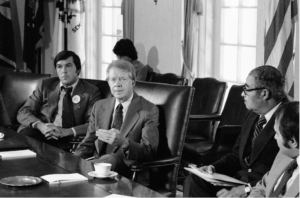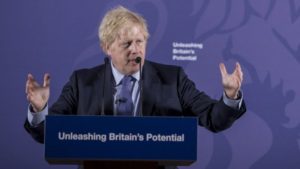
In recent years, leading voices across the American political spectrum have begun to sound eerily alike. The emergence of an “us vs. them” sentiment, as well as frequent accusations of institutions as “enemies of the people” in mainstream politics, are all telltale signs of the rise of an infamous phenomenon in American government: populism.
George Packer, a writer for the September 7, 2015 issue of The New Yorker, defined populism as “a stance and a rhetoric more than an ideology or a set of positions,” protecting it from being claimed by a singular party or political philosophy. Instead, populism ostensibly speaks to the interests of ordinary people, championing their cause against a despised elite class who controls the “establishment.” This notion often includes what Packer calls “a conspiratorial and apocalyptic bent—the belief that the country, or at least its decent majority, is facing imminent ruin at the hands of a particular group of malefactors (Mexicans, billionaires, Jews, politicians).” Leaders who exploit this rhetoric often display charismatic connections to the common people, thus giving them special legitimacy to pursue the “common” interest.
This inflammatory, anti-establishment political approach has been identified in the rhetoric of two leaders who have recently garnered popularity—Donald Trump and Bernie Sanders.
Both Trump and Sanders entered the presidential arena in 2015, as Obama reached the end of his historic presidency. Trump built his campaign on the dissaffected working class without college degrees, blaming the Democratic party’s acquiescence to unfair trade deals, undocumented immigrants, Muslims, China, etc. as the root of America’s economic issues. At the 2016 Republican National Convention, Trump claimed to be “the voice of the forgotten men and women.” In contrast, Sanders attacked the corporate elite, billionaires and the “one percent.” He called for Medicare-for-All, student loan forgiveness, and a progressive tax reform that would benefit blue-collar workers and minority communities disenfranchised by this chosen enemy.
And while both Trump and Sanders have stayed at the forefront of public consciousness through two contentious election cycles and an infamous presidency, it is clear that the conservative leader has been more successful in his populist approach, having won the Presidency and with the help of the Senate majority, reformed the Judiciary.
So why is it that, today, Trump is President, while Sanders remains on Capitol Hill as an unproductive senator? Why is the GOP, in the words of Speaker Nancy Pelosi, “a cult of personality for Donald Trump,” while the Democratic Party experiences a schism between progressives and moderates? Why, exactly, has populism worked for the right but not the left?
Neither Donald Trump nor Bernie Sanders began their first presidential campaigns with any history of party loyalty—a quality which strengthened their appeal to everyday voters. In the case of Trump, his status as a billionaire, businessman and political newcomer following an 8-year Democratic term, embodied the expression of working-class grievances under the Obama administration. This, along with his sentimental mantra of “Make America Great Again!” as a callback to the Reagan-era government, quickly won over many conservative politicians, despite his unfamiliar face in politics.
Sanders, however, had already existed within the political arena as an independent. Establishment Democrats, recognizing Sanders’progressive agenda from his terms as Vermont’s senator, recognized his new Democratic Party affiliation simply as means to improve his chances in the presidential election. His candidacies in both the 2016 and 2020 presidential primaries were accompanied by few endorsements from prominent government leaders relative to his moderate opponents. In comparison to Trump, Sanders’ calls to tear down the Democratic establishment certainly did not resonate with the Democratic party nearly as strongly as Trump’s did with the GOP in 2016.
But what about the voters? Another reason for Sanders’ demise was his inability to appeal to the black population—or racial minorities at all—in both 2016 and 2020. Sanders’ fervent, emotionally charged populism, antagonizing the uber-rich and multinational corporations, only successfully resonated with younger generations, most of whom historically fail to turnout on election day. Older Democrats remained split, or even disapproving of Sanders, especially among black and brown communities making up the minority votes essential for candidates to succeed. In 2020, these voters were more drawn towards Biden, whose campaign was emblematic of a familiar Obama administration and moderate politics. Sanders’ strategy to create a political revolution against the 1% elite failed as Americans don’t vote based by economic class, but rather, by party or identity group (race, creed, etc.). While Sanders did not explicitly center his 2016 campaign on identity groups, the 2020 campaign made a more conscious effort to recognize the intersections between class and race. However, it still wasn’t enough to earn him the party’s nomination.
The GOP constituency—rural, white males without college degrees—was a completely different story for Trump. His movement was based on re-igniting cultural resentments and sympathizing with nostalgia for a lost era of American “greatness” and economic flourishing. Trump consistently employed rhetoric of nationalism, racism, and American exceptionalism in his politics, readily blaming foreign countries and immigrants for “stealing American jobs.” Feeding into the notion of American superiority, Trump used the distant “foreign enemy” to galvanize small-town voters through national pride. Since communities of color already make up a small percentage of the Republican electorate, these frequently racist appeals did not diminish his political strength.
Despite Sanders’ strategic shortcomings within the core Democratic constituency as compared to Trump with the GOP, he strayed from his Democratic counterparts in how he could surprisingly attract Trump’s voter base (shown consistently in head-to-head polling in the 2020 Democratic primaries). Bernie Sanders knew how to talk to economically precarious white Americans, dissatisfied and distrustful of establishment institutions, but alienated the voters of color indispensable to the Democratic base.
What has made right-wing populism so potent is not just its particular political strategies, but the receptibility of its constituency towards the grievance-driven politics of American struggle. The problem with Bernie Sanders and his left-wing populism is that an “uber-rich, elite” enemy doesn’t fit into the traditional narrative of American prosperity and national identity. His adherence to class conflict rather than race or other identities in his politics, coupled with his shaky affiliation with the Democratic party, failed to convince voters of his promises for a better presidency. As a whole, America simply isn’t fond of the idea of a democratic socialist with an ambitious, ideologically radical agenda.
We saw it this spring: Sanders’ 2016 campaign essentially repeated itself as he lost the primary once again to a centrist, establishment Democrat—the party’s nominee Joe Biden. Meanwhile, Trump holds immense power in office with the Senate and the judiciary on his side.
The American people have shown time and again that the form of populism that works in our patriotic culture needs some incorporation of nationalism, at times racism, to thrive. For the sake of our societal progress, perhaps it is time for politicians to abandon populism—that is, until America learns a lesson and can move past racial, religious and national biases for our collective good.



